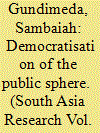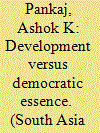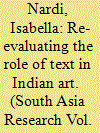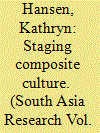| Srl | Item |
| 1 |
ID:
091724


|
|
|
|
|
| Publication |
2009.
|
| Summary/Abstract |
Equality of treatment for all citizens and their cultures in public places is one of the prominent declarations of the secular Constitution of India. The hegemony of Hindu culture in the public sphere, however, reflects a dichotomy between stated declarations and social reality. Placing Dalits at the bottom of the caste hierarchy, if not outside it, 'mainstream' Hindu culture not only marginalised but importantly rejected the Dalits and their culture. This article examines the saga of the demand for a beef stall by the Dalit students in Hyderabad Central University and argues that the rejection of the culture of any community injures the human agency of that community. It is proposed that such injury can be healed only by a dialogical process, involving assertion of positivity and pride in the culture of the injured and positive recognition of such assertion by the injurer. Democratisation of the public sphere can be actualised by according representation to marginalised cultures, but in addition such representation needs to be accompanied with respect.
|
|
|
|
|
|
|
|
|
|
|
|
|
|
|
|
| 2 |
ID:
091727


|
|
|
|
|
| Publication |
2009.
|
| Summary/Abstract |
This article reflects on the role of voters' preference for democratic essence over development-related issues in the 2005 Haryana and Bihar Assembly elections. Based on analysis of these elections, it is argued that in a society where the distributive effects of development are less than egalitarian, economic deprivations are reinforced by socio-political inequality, but democracy still promises to be a great equaliser and source of empowerment for the masses. Democratic issues therefore appear to have greater electoral and political appeal than promises of 'development' or small morsels of favour to entice an electorate. This finding indicates an increasingly sophisticated understanding of the Indian electorate about the critical relevance of democracy.
|
|
|
|
|
|
|
|
|
|
|
|
|
|
|
|
| 3 |
ID:
091722


|
|
|
|
|
| Publication |
2009.
|
| Summary/Abstract |
This article seeks to rediscover and contemporise the importance of using the shastras, Sanskrit technical treatises, as a standard of critique to analyse Indian art. The applicability and interpretative value of this approach for the study of Indian art history is exemplified by a case study of the miniature paintings representing the image of Shri Nathji in Nathdvara. Analysing the image of Shri Nathji as it appears in Nathdvara miniature paintings from different shastric points of views, including the theories of measurement and proportion, postures, mudras and rasa theory, the article proposes to include in the definition of shastra not only canonical textual sources but also practical/visual and oral/verbal transmitted knowledge. While textual concepts are used as a methodology for the reading of the image of Shri Nathji, the canonical shastric theories are considered side by side with such oral and practical knowledge in an attempt to redefine the concept of 'text' for Indian tradition, and especially to further our knowledge on the relationship between text and image in Indian art.
|
|
|
|
|
|
|
|
|
|
|
|
|
|
|
|
| 4 |
ID:
091725


|
|
|
|
|
| Publication |
2009.
|
| Summary/Abstract |
Both the rural-based Nautanki and its urban counterpart, the Parsi theatre, remain part of the cultural scenario of modern India and continue to contribute to the ongoing negotiation of India's composite culture. Part of the appreciation of these older stylized theatre genres comes from awareness of their hybrid character. As emblems of composite culture, these theatrical traditions remind viewers of a popular secular outlook that is still within reach. This article discusses two performances observed during 2004 in New Delhi, of Amar Singh Rathor and Yahudi ki Larki, both canonical popular texts. It is argued that the revival of these plays owes much to their ability to serve as allegories within the current polarized cultural and political climate. The discussion suggests the continuing potential of the impulse to counter neo-nationalist ideology by means of popular media such as Nautanki and Parsi theatre.
|
|
|
|
|
|
|
|
|
|
|
|
|
|
|
|